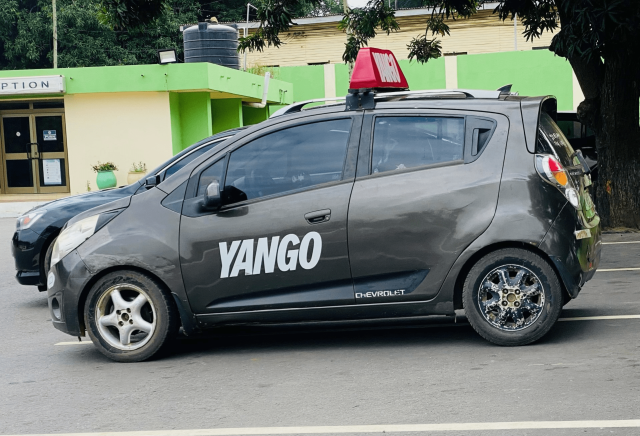By Gifty Xornam Adonoo
In the streets of Ghana, aspirations collide with economic challenges, with a new phenomenon taking hold: ride-hailing services. These services have emerged as a beacon of hope for jobs, drawing countless individuals to become entrepreneurs.
In this Special Report, Gifty Xornam Adonoo delves into the captivating story of how ride-hailing services are shaping the transport landscape of Ghana and the impact on the modern-day movement of goods and the lives of Ghanaians. The growth of on-demand transport apps, otherwise known as ride-hailing services, has revolutionised the movement of people, and it is patronised by individuals with multiple ride-hailing apps on their devices. With urban populations increasing, ride-hailing is becoming a primary mode of transportation, potentially eliminating the need for one to own a personal vehicle. It provides people with disabilities who may not be able to drive themselves with greater mobility and independence.
In Ghana, some ride-hailing services operating are Bolt, Yango, Uber, and Shaxi. Sharing his insight about ride-hailing services, a Bolt driver, Badger, said the service has deteriorated due to the high cost of living, fuel, and the influx of new drivers due to unemployment in the country.
“The reason why I chose this type of work is that I was once a company worker and I earned 400 cedis a month, and that one wasn’t enough for me so one friend of mine introduced me to this Bolt business. On the first day that I gave it a try, I was able to earn 1,000 cedis and if I take petrol and other expenses from it, I still had more than I earn monthly, so I decided to choose the Bolt business and go by it.”
A 27-year-old University graduate who now works for the Uber platform, Simeon Ofori, said the Ride-hailing service gives him the flexibility he needs to work.
“It is very flexible, and yes, I actually enjoy my peace. Back then, when we started, business was good. There were less people in the system, so I could actually make like 1000–1200 cedis, and after giving 20% commission to the company, I still have roughly 800 cedis.”

Simeon said the only problem with the movement of goods is that his car cannot carry heavy and fragile goods, and he is sometimes forced to pay for damaged goods.
Some passengers who mostly make use of these ride-hailing services shared their views with GBC News. A 23-year-old CEO of Bigail’s Online Shop, Abigail Cobbinah, said ride-hailing provides an efficient way to transport and deliver goods, as she does not have access to larger delivery services. She is also able to track her deliveries.
“There are these times that customers make purchases and say, ‘I need them today, can I get it today? I need them for this, I need them for that’. So with times like that, it’s very difficult to get a rider to do the delivery, so you just order a ride, and the driver takes it to the customer that very day. Comparing these ride-hailing services to the other delivery services I’ve used so far, they are reliable, convenient, and swift, and I’ll recommend them to other business owners.”
A 24-year-old National Service Person, Herman, said ride-hailing provides a more convenient, flexible, and safe way to travel around.
“The things that I love about ride-hailing services are the comfortability, the convenience, and how readily available the cars are. Prior to these days, you’d probably have to walk to the junction or bus stop to chatter a taxi, wait for a trosky and queue, and sometimes these queues are quite long. All these amount to stress, but now, in the comfort of your home, you can just pick up your phone and input the location you intend to go.”
Some taxi drivers believe these ride-hailing services have disrupted the taxi business, threatened their livelihoods, and created increased competition. According to Mr. Osei, has pushed taxi operators to adapt new ways in order to stay in the transport business.
“Previously, the taxi business was lucrative. Each person is 10 cedis, so four people will be 40 cedis. The taxi really helps us. Before the arrival of Bolt and Uber, I could complete five trips before noon because there was no Bolt, so everybody was patronising the taxi.”

An Economist, Peter Terkper, says ride-hailing services have impacted the economy positively by helping people be productive in their daily movements and business transactions. Mr. Terkper says in order to create balance between traditional taxi services and ride-hailing services, the taxi union should introduce new rules and upgrade their services to stay in the transportation business.
“Ride hailing has come to solve a very big problem where people want to move easily and can be in their various homes and have access to the services of these providers. The economy and the world as a whole are moving in a direction where everyone must understand and move in that direction. I’m talking about technology. To bridge the gap between ride-hailing services and traditional taxi services,the various Transport Unions must also look at how they will have similar systems so that they can take the basic details of the various passengers who come and take cars at their stations, create a platform, and add them so that anytime the passengers need their services too, they can get them. Traditional taxi service providers should come into the system and see how they can use ride-hailing to improve their services. Other than that, they will be out of business. They will totally collapse.”
Mr. Terkper says that although these ride-hailing services are security-friendly, he foresees the influx of new drivers making traffic congestion worse if roads are not expanded.
“A time is coming when nobody will like to go and be joining queues at various bus stops saying they want to travel. We are going to a time where you will see cars moving to people’s homes to go and pick them up. On the road, we have to look at how to create so many roads to cut across because what it will mean is that people would like to have access to various locations and new development areas where they can be able to provide these services.”
With the emergence of ride-hailing technology, potential riders can use their smartphones to book rides from any location, and drivers do not have to waste fuel roaming the city and surrounding areas looking for their passengers.














